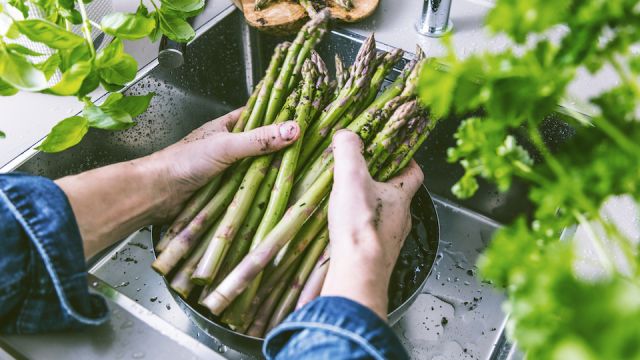Asparagus (Asparagus officinalis) is a perennial flowering plant whose young shoots are used as a delicious spring vegetable. If you love to roast tender spears tossed with olive oil and seasonings, perhaps it is time to grow some of your own. Although it takes a while for asparagus crops to take off, there is nothing like the taste of these homegrown, green spears.
Once asparagus matures, usually about two to three years after planting, you will have an abundant supply of this popular veggie each spring for up to twenty to thirty years.
New varieties are easier to grow and produce a higher yield
If you planted asparagus with your grandparents, you may be familiar with digging trenches up to 18 inches deep and backfilling with a mix of compost and soil. In short, it was quite a lot of work. Thankfully, newer varieties of asparagus require less work and produce about twice as many spears per plant. Hybrids are male cultivars, and there is no energy wasted on seed production, which means it can all go to the spears. Besides, newer types do not produce baby plants, which can drain nutrients and compete for space.
Preparing and planting asparagus
Before you plant a new asparagus bed, be sure to eradicate the weeds and grasses from the planting area entirely. This is a critical step, as asparagus will not tolerate competition from weeds.
Once your bed is weed-free, dig a 10-inch deep trench that is about a foot wide. Add about 3 inches of compost to the bottom of the trench along with some rock phosphate, a natural mineral powder that will promote strong root growth.
Mound up the soil to form a ridge along the length of the trench. This ridge will support the roots and provide excellent drainage. Make sure that the top of the ridge sits at soil level.
Lay the plants out along the ridge at a distance of about 18 inches. This will give each plant enough room to spread. Place each of the crowns on top of the ridge and allow their roots to hang over the edges. Once you have your crowns placed, cover them with about 3 inches of soil, creating a small ridge, then firm them in. Water the crowns well. Apply a healthy dose of organic fertilizer in early March before shoots are produced.
Harvesting
You will see small spears appear the spring after planting. Resist the temptation to harvest these spears. Allow the foliage to grow to help feed the plants and make them healthy. In the second year, you can harvest some (not all) of the spears when they reach about six inches tall. By the third year, you will be able to harvest a full crop from April to the beginning of June.
Cut spears at about one inch below ground level using a sharp and clean knife. Because asparagus shoots are quick growing, you need to check your crop daily. Be sure to stop harvesting around the beginning of June and allow any remaining spears to develop foliage.
Maintaining your asparagus bed
Asparagus is not a demanding crop, but it does appreciate some hand weeding during the growing season. It is important to do your weeding by hand as a hoe can damage the shallow root system of the plant. Keep plants well-watered during hot periods so that the roots do not dry out. In the fall, when the foliage turns yellow, simply cut it down to the soil level. Mulch the bed well to protect plants over the winter period.
-Susan Patterson



